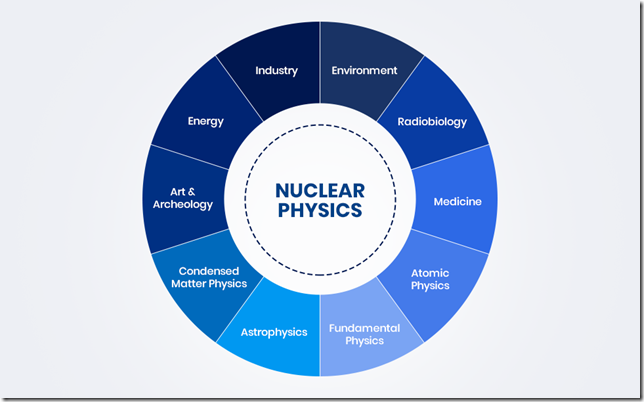The C12 Commission on Nuclear Physics was established by IUPAP in 1960 to promote the exchange of information and views among the members of the international nuclear physics community. Presently, fourteen physicists from different countries are members of C12. They represent many fields of nuclear physics including: a) nuclear properties and reactions; b) hadronic structure; c) nuclear astrophysics; d) quark matter physics; e) fundamental symmetries; f) nuclear instrumentation and technology; g) applications of nuclear physics.
Thus, nuclear physics spans distance scales from as small as quarks (~10-18 m) to as large as the universe (~1026 m). It is the key to understanding the stars and the production of the elements of the Periodic Table. A vast array of techniques and instruments, originally developed for nuclear physics, are used in medicine for imaging and treatment. Particle accelerators were invented by nuclear physicists as early as 1930 and quickly became the most important tool of nuclear research. Today there are more than 30000 accelerators in the world, most of them being used in industry and medicine. Nuclear physics thus relates to many fields of science and it encompasses a huge range of applications as shown in the figure above. C12 is an expert resource to IUPAP on these matters and on education and training of the next generation.
C12 & IUPAP Working Groups
C12 are liaised with working groups such as WG9 on International Cooperation in Nuclear Physics and WG14 on Accelerator Science. WG14 maintains a broad view, touching on fields such as material sciences, condensed matter physics, biology, medical isotopes, medical imaging, plasma sciences, to name a few. WG9 was set up in 2003 on the initiative of C12. Among its members are the chairs of the long range planning committees, the chairs of international nuclear physics associations, and representatives of the large nuclear physics research establishments worldwide. Operations within C12 and WG9 form a central part of the global network of nuclear physicists. One endeavour is to create mechanisms and opportunities for enhancing international cooperation and collaboration in nuclear science. Another is to foster cross disciplinary research such as those found in underground laboratories for particle, nuclear, and nuclear-astrophysics, and neutrino science.
Examples of work that C12 undertakes
- Conference Sponsorship: On recommendation from C12 IUPAP supports international conferences within the field of nuclear science.
- Young Scientist Prize in Nuclear Physics: The IUPAP YSP in Nuclear Physics is awarded every third year. Typically around 30 nominations are evaluated each time. The award ceremony of the prize winners takes place at the International Nuclear Physics Conference, INPC, the largest and broadest in scope in nuclear physics.
- Elements of the Periodic Table: When claims for the discovery of a new element of the Periodic Table is being put forward it is the task of IUPAP and IUPAC to validate the claims. To this end a document was produced in 2017: ”IUPAC and IUPAP Procedures for Validating Claims for the Discovery of New Elements and Naming those Elements”. It was realised that the criteria and rules that are to be followed in the validation procedure also were in need of a revision. A group of scientists, the Joint Working Group, with C12 participation, were appointed by the two unions to undertake that revision. The report was published in the journal Pure and Applied Chemistry in 2018.





